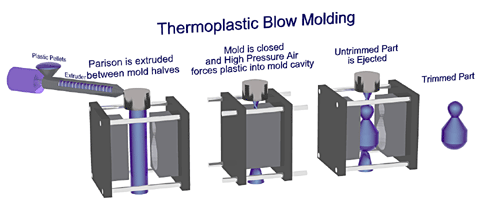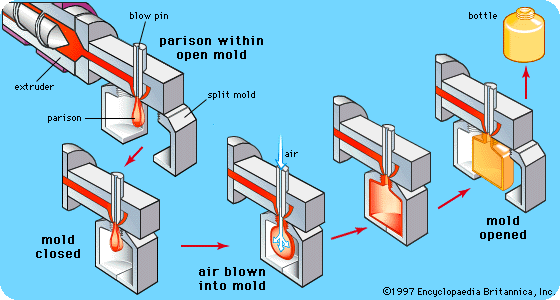Injection-Blow Process

The injection-blow process combines the function of blowing with the precision of injection molding; it requires a parison-forming mold with integral neck ring, multiple core rods (blow pins) and a blow mold. A core rod is moved into the parison mold and material is injected into the mold to form a Precision parison with a fully formed neck. Within certain limits, the parison can be shaped internally by the core rod,and externally by the parison to control the uniformity of the wall thickness of the blown product, lie the body of the parison is still hot and plastic, the core rod with the Parison on it is lifted from the parison mold and then transferred to the blow mold. Air is introduced through the core rod to blow the parison to the final form of the product. After cooling, the product is removed from the core rod as a completely finished article without the need for secondary trimming operations.
The injection-blow process is used to manufacture products requiring close control of dimensions, weight, capacity, and material distribution. There are three main types of injection-blow machines commercially available. They are discussed below.
Three and Four-Station Rotary Machines. The parison mold and blow mold are mounted in a fixed radial position with respect to each other. The core rods are mounted in a head which indexes intermittently to transfer the core rods from the parison station to the blow station and then to an ejection station. The four-station machine has an extra station, after the ejection station, for conditioning (heating or cooling) the core rod before it is transferred into the parison mold.
The rotary machines are the most widely used of the injection-blow machines because of their versatility in producing precision containers in a size range from a fractional ounce to 64 ounces.
Two-Station Machine. In comparison with the four-station rotary machine, the ejection and conditioning stations have been eliminated. Ejection of the finished product occurs as the blow mold is opened. Conditioning in a two- station machine is normally accomplished by the circulation of temperature-controlled fluid through the core rods.The two-station machines are used primarily for producing specialized containers for paint or food products.
Adaptive Tooling. Various kinds of systems have been designed and built to adapt standard injection molding machines for blow molding. Such systems generally find application in injection molding companies that want the flexibility to occasionally use their standard machines as blow molders.

Formed Neck Process
In this process, the neck of the container is precision-formed by pressing the neck ring integral blow pin against the extrusion die and extruding the plastic material into the interior space. After the neck is formed, the neck ring and blow pin move away from the extrusion die while additional material is extruded at a controlled speed for the section of the parison which form the body and base of the container. In one variation of the process, a short blow pin is used and the parison is pinched off by the mold halves which close on it. In another variation, a long blow Pin is used which supports the entire length of the parison; when the desired parison length has been extruded, it is cut off and the parison is rotated 180° by the blow pin to the blow mold. Commercially available machines are not yet in wide use, but proprietary machines employing the first variation of the process have been used for many years.
